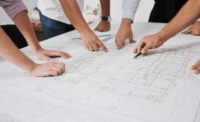I have always enjoyed building systems retro-commissioning because it’s like a super-sized lab experiment. The process boils down to collecting, reviewing, and understanding available data and applying the laws of physics to fill in the missing pieces. This often requires testing numerous theories until one of them is proven to answer an outstanding question about how a system functions.
Before responsibly making performance and energy conservation recommendations, it’s necessary to understand the existing systems’ operation to a level of detail often not documented in as-built drawings or manuals. As such, retro-commissioning conclusions and recommendations should never be based solely on available documentation. That would be like limiting a research project to the literature search. Documentation review is the necessary first step, but it should only be used to formulate questions and theories to be investigated in the field. Data analysis and experimentation is always necessary.
New construction projects, on the other hand, should not be treated like laboratory experiments or high school science projects. Particularly, in the traditional design-bid-build project delivery process, the concept of, “Let’s build it and see if it works,” should be a non-starter. The whole idea behind having a “design” phase in the design-bid-build process is to spend the time to engineer building systems that are:
- Designed, integrated, and modeled based on the laws of physics;
- Fully developed with components, connectors, and controls; and
- Clearly defined, coordinated, and unambiguously communicated.
There should be nothing left to the imaginations of the bidding contractors. Their job is to determine how to most efficiently and effectively execute the design, not to complete it and not to figure out how to make it work.
On the front lines of commissioning, we’ve seen a trend toward more and more construction phase improvisation. When involved in the design phase, commissioning has an opportunity to identify danger signs and recommend more thoughtful and thorough design, but our input is sometimes not valued to the point of making much difference. That means we carry our concerns into the construction phase and, on behalf of the owner, start playing the role of principal investigator, facilitating the project team’s research project of figuring out how the systems are supposed to work.
This is critical in order for functional performance testing at the end of construction to be meaningful, successful, and completed in a timely manner. Sure, full-service commissioning often includes facilitating “controls integration” meetings, but I’m talking about controls integration on steroids. This isn’t simply about making sure all of the well-defined individual systems will talk nicely with each other after start-up and programming. We’re talking about:
- Finalizing/clarifying individual equipment and system components, sequences of operation, and user interfaces;
- Reconciling the specified equipment and controls with products and systems actually available from vendors; and
- Encouraging determination of operational set points and confirmation of system capacities to meet those set points in order to achieve the owner’s performance requirements.
If this work is not accomplished and well-documented by the end of construction, functional performance testing will essentially become a laboratory experiment, like retro-commissioning. The result will be documentation of what the project team delivered in the end. However, the chances of it being what the owner needed, expected, or required are slim.
Granted, this is better than a noncommissioned project, where it would be left up to the owner’s facilities staff to experiment with the system in order to decipher what they’ve got. However, that’s not how the process is supposed to work. This type of detailed engineering, analysis, and operational specification should be performed during the design phase.
On the surface, I know this sounds like design engineer-bashing, but I do realize it is a larger issue than that. For numerous reasons, design engineers are not necessarily being given the appropriate time or compensation to fully engineer a project. This may lead to their engineering skills and passions atrophying to the point where we might have a whole generation of designers who have never really had the chance to do it the right way. In this day of increasing sophistication and integration of building systems, we need to fix this so that research and development is conducted before construction starts.





